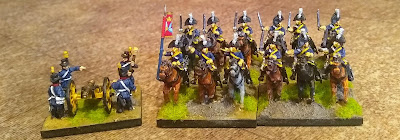I wasn't intending to try Infamy just yet but being unable to play at the club anymore and a visit to the Orc's Nest shop resulting in an impulse purchase of the rules and cards last week changed that.
After a quick read through and the impression that it was basically Sharp Practice with sticks I thought I'd give it a go as a solo game using my 25mm Late Romans as Early Imperial Romans and some Carthaginian Gaul's and Spanish as Germans.
With room for only a 4x4 ft table I used just the fixed lists and put down some terrain. The Romans quickly appeared and started to move into the Germanic wasteland:
The Roman archers are ambushed by some Germanic warriors!
The archers are broken quickly and the Germans pile into the Legionaries behind:
The Romans stand fast and repulse the Germans:
Some Auxila arrive and advance while the Germans deploy slingers (heavily influenced by Spanish fashion!) in the broken ground as the ambushing German warriors fall back:
The German war leader arrives with the German cavalry to support the slingers:
The rest of the Germanic warband moves out from a forest and begins to build up fervour:
The Auxila are charged by the German cavalry. Meanwhile the German slingers have been inflicting kills on the Legions:
The Auxila only just hold on and the cavalry fall back. Both have large amounts of shock:
The Legionaries continue to advance on the German warband but take more losses from the slingers:
The Germanic warband leader attempts to raise the fervour of his men. They are less than impressed and appear unenthusiastic to face the advancing Romans losing most of their fervour!:
The Romans charge home throwing their pila to little effect:
The first round of combat goes largely to the Romans with the elite German warriors in the centre coming off worst:
In the second round two lots of Germans fall back but the one on the left pushes back some Legionaries that had been weakened by the German slingers. A second unit of Romans, also weakened by the slingers, falls back as well:
The Germans break the Legionaries on the Roman left:
Most of the units involved now have too much shock to do anything else:
The German cavalry having rallied off their shock close on the Auxila and throw javelins at them. Combined with losses from the German slingers the Auxila break:
With the Romans only having one effective group left (the Legionaries on the far left) the battle is over and the Germans have triumphed over the invaders:
After a slow start I quite enjoyed the game. It is a bit different to Sharp Practice (which to some extent is confusing) and, on this small game, it seemed quite hard to inflict losses on units (though it was easy to inflict shock on them). At the end of the game both sides still had high force moral levels despite losing a few units each. The way the flag cards are used is quite different as you can't use them to activate units apart from at the phase end and they are mainly used for actions instead. I'll definitely need to re-read the rules again as I'm sure I did several things wrongly.
The German slingers were very effective but the warband groups are much less effective than the Legionaries so for the Germans I suspect it is vital to weaken the Legions before they contact the warband units. I also think they could have made more use of their ambush ability but of course that's hard to do in a solo game.
When we are able to play again I think I will try to arrange a game and see how it works on a full-size table with a proper scenario.

























































